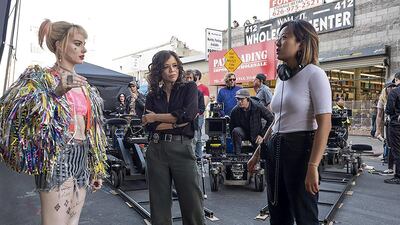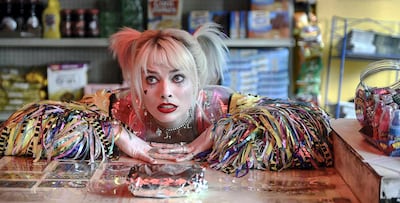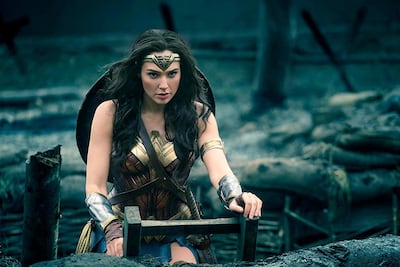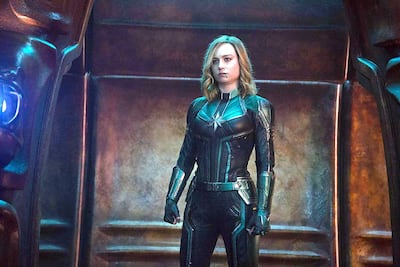If early critical reactions to Birds of Prey, which lands in UAE cinemas today, are any indication, it looks like DC's cinema universe will have another hit on its hands by the time box office figures start rolling in.
It's been well-publicised that Warner Bros had a shaky start to its attempts to compete with Disney's world-conquering Marvel Cinematic Universe – the reviews for 2016's Suicide Squad and the following year's Justice League ranged from terrible to not very good, and while neither exactly bombed at the box office, nor did they enter the rarified billion-dollar-plus atmosphere of Marvel's most successful movies.
DC's most popular character Batman, meanwhile, still seems to be struggling to replicate the on-screen success of Christopher Nolan's stunning, pre-DC extended universe trilogy of films, although on-set reports suggest Matt Reeves may be about to at least partly resolve that with forthcoming reboot, The Batman.
Warner seems to have been taking a slightly different route with its DC properties while we await its next big-ticket outing with The Caped Crusader, and success has followed. Recently, the studio has largely eschewed the huge budgets of its early entries in the DC franchise. Last year's Shazam! started this trend, grossing close to $400 million (Dh1.4 billion) globally on a modest $100m budget, and garnering a 90 per cent rating on review aggregator Rotten Tomatoes (Suicide Squad managed just 27 per cent, despite a near-$200m budget).
Then, in October, Joker became the first movie to gross more than $1bn globally without a China release, despite its R-rating. And, despite having been made on a comparatively measly $63m budget, it amassed 11 Oscar nominations, including the coveted Best Picture, Best Actor and Best Director awards.
With a $75m budget, Birds of Prey sits in between the two, and significantly below the $200m average that Warner spends on a DC movie, or the $300m it spent on Justice League. But it's not only in terms of budget that Birds of Prey is breaking the superhero movie mould. The film can make a reasonable claim to being the most female-centric in the genre, to date, with its cast of four women leads (Margot Robbie, Rosie Perez, Jurnee Smollett-Bell and Mary Elizabeth Winstead) pushing Ewan McGregor's villain, Black Mask, into supporting actor territory. The film is also written and directed by women – Cathy Yan and Christina Hodson.
Birds of Prey is essentially an entirely female-driven project. It was developed and pitched by producer / star Robbie herself through her Lucky Chap production company, following her success as Harley Quinn in Suicide Squad. Her maniacal anti-hero was one of the high points of an otherwise disappointing couple of hours of cinema, and inspired millions of fancy-dress outfits in the years that followed. Now, free from the shackles of being "Joker's girlfriend", Quinn's popularity looks set to soar.
Of course, Birds of Prey isn't the first successful female-led superhero movie. That honour falls to another DC title, 2017's Wonder Woman, also directed by a woman, Patty Jenkins. (Technically 2005's Elektra, starring Jennifer Garner, was the first of the genre, but it bombed at the box office). Gal Gadot's titular heroine finds herself surrounded by male helpers, however, in a story co-written by Allan Heinberg and Zack Snyder, who also co-produces.
Marvel, too, jumped on the female superhero bandwagon with 2019's Captain Marvel. That film is co-written and co-directed by Anna Boden, alongside her regular filmmaking partner Ryan Fleck, so it does score half points on the "women in charge" front, but as is usually the case with Marvel outings, Kevin Feige produces.
It's worth noting, too, that the film's hero, Carol Danvers, prior to receiving her superpowers, achieved her position in life through success in the military – an undeniably male environment that Danvers is required to adapt to in order to win the acceptance of her peers. Quinn and her cohorts have achieved their positions in society entirely on their own terms, even if those positions are slightly less respectable than Danvers's decorated military hero. Quinn may be a psychotic anarchist, but she's her own psychotic anarchist, she didn't borrow any of the trappings of the male world to get there.
That's not to take anything away from these two trailblazers for the genre that preceded Birds of Prey. All three films have undoubtedly represented a huge step forward for women in the male-dominated superhero movie genre, and compare extremely favourably with the most successful films in the genre in terms of female screen time and representation both on and off screen.
According to research compiled by online gaming portal Bojoko last year, the 10 highest-grossing superhero movies up to April's Avengers: Endgame featured a grand total of zero female directors. There were just 17 female main, named characters in the 10 films compared to 52 men, and female superheroes were on screen for a total of six hours and 17 minutes, while their male counterparts took up a huge 20 hours and 39 minutes of screen time.
Intriguingly, perhaps the most female-friendly of the 10 films the research looks at is 2018's Black Panther, already heralded as a breakthrough for diversity thanks to its largely black cast. That film features an impressive 16 named female characters to just 10 male – compare that to bottom-placed The Dark Knight Rises, with just three named females to 15 men.
Black Panther is still directed by a man – Ryan Coogler – though, and the film's male stars Chadwick Boseman (The Black Panther) and Michael B Jordan (Killmonger) are on screen for longer (70 minutes between them) than the entire female cast combined.
Birds of Prey won't succeed with audiences or critics purely on the basis of whether it puts women to the fore, of course. The biggest question audiences will care about is simply "is it any good?" Judging by early critical responses, the answer seems to be a resounding "yes."
It pushes female characters, and filmmakers, front and centre, while avoiding any chick-flick cliches, taking pride in an R-rating for its violence and adult themes. It also avoids any men saving the day – Harley and Joker have split up at the film's outset, and the story is very much that of her finding herself, as evidenced by the film's unwieldy full title Birds of Prey (and the Fantabulous Emancipation of One Harley Quinn. The fact the film even does away with the impractical "heels and short shorts for action scenes", that were roundly pilloried in Suicide Squad, can surely only bring the film further acclaim.




